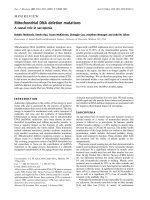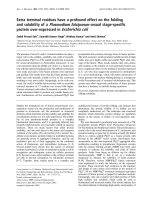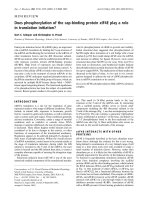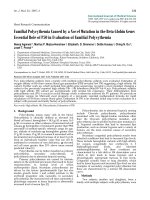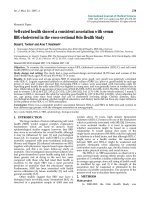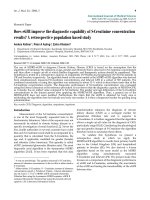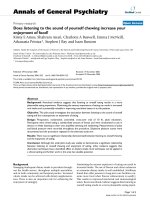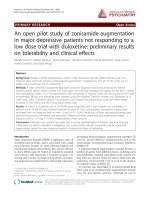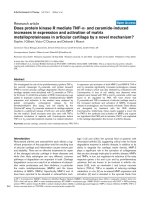Báo cáo y học: "Does serum procalcitonin have a diagnostic value in febrile adult patients presenting to the emergency department" potx
Bạn đang xem bản rút gọn của tài liệu. Xem và tải ngay bản đầy đủ của tài liệu tại đây (39.27 KB, 2 trang )
Page 1 of 2
(page number not for citation purposes)
Available online />Hausfater and colleagues stated that in febrile adult patients
presenting to the emergency department (ED) a procalcitonin
(PCT) ≥ 0.2 mcg/l can help physicians to identify
bacterial/parasitic infections [1]. We disagree and want to
illustrate that by calculating likelihood ratios (LR). A LR is a
semi-quantitative measure of the performance of a diagnostic
test, expressing the magnitude by which the pre-test
probability of a diagnosis in a given patient is modified by the
results of a test [2]. A positive result with a high positive
likelihood ratio (LR+) can rule in a diagnosis. A negative
result with a low negative likelihood ratio (LR-) can rule out a
diagnosis. LR+ for the emergency physician 1.98, LR- 0.26.
Using prevalence of bacterial/parasitic infections as pre-test
probability, a positive diagnosis by the physician modified
pre-test probability from 69% to 82% and a negative
diagnosis to 37%. PCT ≥ 0.2 mcg/l, LR+ 1.88 and LR- 0.39.
Pre-test probability changed to 81% by PCT ≥ 0.2 mcg/l and
to 47% by PCT < 0.2 mcg/l. The performance of the
emergency physician is based on anamnesis, physical
examination and traditional markers such as neutrophil
leukocytes and C-reactive protein (CRP). For example, CRP
≥ 40 mg/l, LR+ 2.0, LR- 0.39. Pre-test probability changed by
CRP ≥ 40 mg/l to 82% and to 47% by CRP < 40. Will the
likelihood ratios of the emergency physician change much
when PCT is added to the spectrum of available diagnostic
tests? We don’t think so.
Competing interests
The authors declare that they have no competing interests.
References
1. Hausfater P, Juillien G, Madonna-Py B, Haroche J, Bernard M,
Riou B: Serum procalcitonin measurement as diagnostic and
prognostic marker in febrile patients presenting to the emer-
gency department. Crit Care 2007, 11:R60.
2. Halkin A, Reichman J, Schwaber M, Paltiel O, Brezis M: Likeli-
hood ratios: getting diagnostic testing into perspective. QJM
1998, 91(4):247-258.
Letter
Does serum procalcitonin have a diagnostic value in febrile adult
patients presenting to the emergency department?
Jos AH van Oers
1
, Jaap E Tulleken
2
and Jan G Zijlstra
2
1
Department of Intensive Care, St Elisabeth Hospital, Tilburg, The Netherlands
2
Department of Intensive and Respiratory Care, University Medical Center, Groningen, The Netherlands
Corresponding author: Jos AH van Oers, E-mail:
Published: 14 November 2007 Critical Care 2007, 11:422 (doi:10.1186/cc6172)
This article is online at />© 2007 BioMed Central Ltd
See related research by Hausfater et al., />CRP = C-reactive protein; ED = emergency department; LR = likelihood ratio; PCT = procalcitonin; ROC = receiver operating curve.
Authors’ response
Pierre Hausfater and Bruno Riou
We thank van Oers and colleagues for their comments. We
agree that likelihood ratios (LR) are useful tests in
interpretation of clinical findings, laboratory tests, and image
studies, although they are little used [1]. However, we do not
think that LR is the unique response to a complex issue. First,
LR is provided for a given predetermined threshold and we
are convinced that the threshold of procalcitonin (PCT) highly
depends on the population tested and the type of infection
studied. Moreover, we recently observed that this threshold is
markedly modified by renal function [2]. It should also be
pointed out that the threshold is usually provided without
confidence interval whereas this information might be very
important [3]. In contrast, the receiver operating curve (ROC)
provides a global assessment of diagnostic accuracy without
any focus on a given threshold. Second, we do not think that
the LR of PCT should be applied to the global population
tested and compared to that of the emergency physician.
Actually, the best way to use LR should have been to identify
the real pretest probability by collecting more accurately the
diagnostic suspicion of the emergency physician, and to test
the LR of PCT in the different subgroups (low, intermediate,
and high pretest probability of bacterial infection).
Unfortunately, we did not assess that in our study. It is likely
that PCT may be particularly useful in patients with an
Page 2 of 2
(page number not for citation purposes)
Critical Care Vol 11 No 6 van Oers et al.
intermediate pretest probability and maybe not in patients
with a low or high pretest probability. This hypothesis
deserves further studies. Thirdly, it should be pointed out that,
in contrast to the etiological diagnosis of the emergency
physician found in the medical chart, we observed that
administration of antibiotics was not always in accordance
with that diagnosis, emphasizing the complex issue of the
prescription of antibiotics and the potential added value of
biomarkers like PCT. Therefore we think that the next
important steps in assessing PCT diagnostic values are the
following: Firstly, assess the LR in subgroups of patients,
according to the pretest probability determined by the
physician; secondly, test an algorithm that includes PCT
measurement; thirdly, test the usefulness of PCT on the
outcome (antibiotic administration, morbidity, mortality) in a
randomized study as recently performed by Christ-Crain et al.
[4].
References
1. Grimes DA, Schulz KF. Refining clinical diagnosis with likeli-
hood ratios. Lancet 2005, 365:1500-1505.
2. Amour J, Birenbaum A, Bertrand M, Langeron O, Coriat P, Riou B,
Bernard M, Hausfater P: Valeur diagnostique de la procalcito-
nine en chirurgie aortique abdominale. Ann Fr Anesth Réanim
2007, 26:R460.
3. Fellahi JL, Hedoire F, Le Manach Y, Monier E, Guillou L, Riou B.
Determination of the threshold of cardiac troponin I associ-
ated with an adverse postoperative outcome after cardiac
surgery. A comparative study between coronary artery bypass
graft, valve, and combined cardiac surgery. Crit Care 2007,
11:R106.
4. Christ-Crain M, Jaccard-Stolz D, Bingisser R, Gencay MM, Huber
PR, Tamm M, Müller B: Effect of procalcitonin-guided treat-
ment on antibiotic use and outcome in lower respiratory tract
infections: cluster-randomised, single-blinded intervention
trial. Lancet 2004, 363:600-607.
